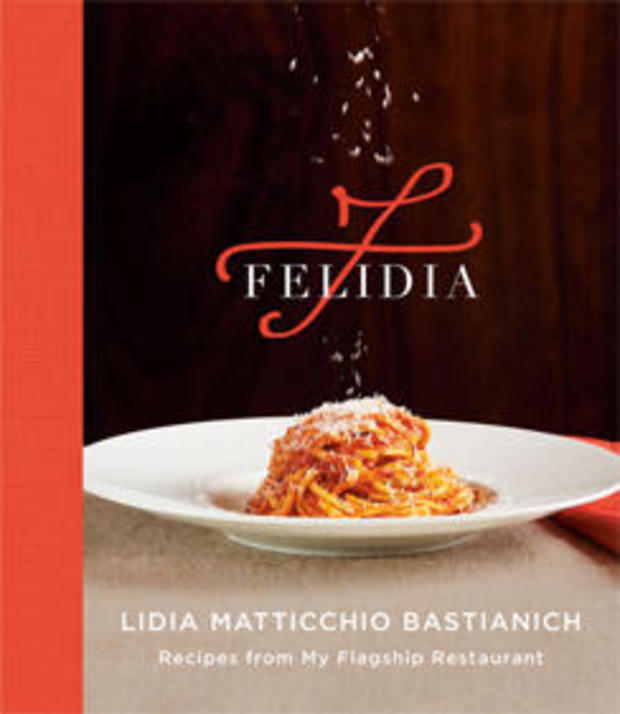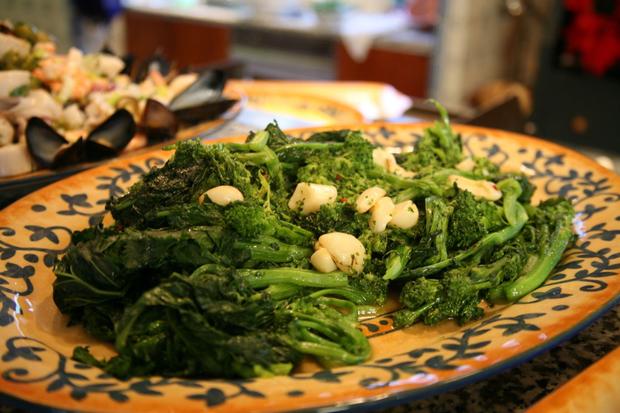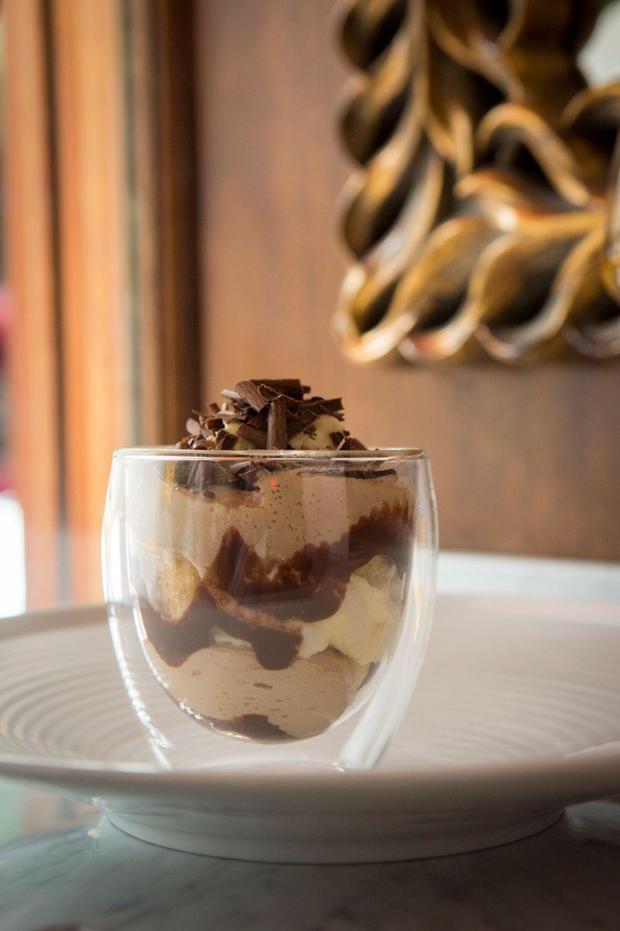The Dish: Lidia Bastianich shares Italian recipes
When Lidia Bastianich and her husband opened a restaurant, she started out hosting, but soon made her way into the kitchen. She’s now the driving force behind four restaurants and half a dozen Eataly food emporiums in major U.S. cities.
She’s also an Emmy-winning TV host and author of best-selling cookbooks, including “Felidia: Recipes From My Flagship Restaurant” (Knopf).
Bastianich joined “CBS This Morning: Saturday” to share some of those recipes:
Chicken Pizzaiola (serves 4)
Ingredients:
- 4 boneless, skinless chicken breasts (about 2 pounds), trimmed of fat and gristle
- Kosher salt
- 1 cup buttermilk
- 1½ cups panko breadcrumbs
- ¾ freshly grated Grana Padano
- Teaspoon dried oregano, preferably Sicilian, on the branch
- 2 tablespoons chopped fresh parsley
- 2 tablespoons chopped fresh basil, plus ¼ cup leaves, and whole sprigs for garnish
- 5 tablespoons extra-virgin olive oil
- 2 cups prepared fresh tomato sauce
- 4 slices low-moisture mozzarella
Season the chicken breasts with salt and place them in a resealable plastic bag. Pour in the buttermilk and marinate in the refrigerator for two hours. Drain the chicken and preheat the oven to 400 degrees. Line a baking sheet with parchment paper.
In a medium bowl, toss together the panko, grated Grana Padano, dried oregano, chopped parsley, chopped basil, three tablespoons of the olive oil and half a teaspoon of salt. Stir to incorporate everything fully into the crumbs. Put the drained chicken breasts in the bowl with the seasoned breadcrumbs one at a time, and pat well on both sides so the crumbs cover the chicken on all sides.
Set the breaded chicken breasts on the parchment paper, arranged so they don’t touch each other. Bake the chicken until the coating is crisp and browned and the chicken is just cooked through, about 15 minutes.
While the chicken bakes, combine the tomato sauce, the remaining two tablespoons of olive oil, and a fourth cup of basil leaves in a blender, and purée until smooth. Season with salt. Pour the purée into a small saucepan, and warm it over low heat.
When the chicken is just cooked through, top with the sliced mozzarella and bake until the cheese is just melted, about two minutes. Spread the tomato emulsion on plates, top with the chicken, and serve.
Pasta alla Chitarra with Amatriciana Sauce (serves 4 to 6)
Ingredients for the pasta:
- 2 cups all-purpose flour, plus more for rolling the dough
- ¼ cup extra-virgin olive oil
Ingredients for the sauce:
- Kosher salt
- 1 small onion, cut into chunks
- 1 small carrot, cut into chunks
- 1 small stalk celery, cut into chunks
- 3 cloves garlic, crushed and peeled
- 2 tablespoons extra-virgin olive oil, plus more for drizzling
- 3 thick slices bacon (about 4 ounces), cut into ½-inch pieces
- ¼ teaspoon crushed peperoncino flakes, or to taste
- One 28-ounce can whole Italian plum tomatoes, preferably San Marzano, crushed by hand
- ¼ cup chopped fresh Italian parsley
- ½ cup freshly grated Grana Padano, plus more for serving
- ½ cup freshly grated Pecorino Romano, plus more for serving
For the pasta, put the flour in the work bowl of a food processor, and pulse several times to aerate. In a spouted measuring cup, beat the olive oil and half a cup of cold water together with a fork. With the processor running, add the wet ingredients to the flour, and process until the dough forms a ball around the blade; add a little more water if it is too crumbly, a little more flour if it is too loose. Once the dough forms a ball, knead in the processor until smooth, about 20 to 30 seconds.
Flour your work surface, dump the dough out, and knead a few times by hand to bring it together in a smooth ball. Wrap in plastic wrap, and let it rest at room temperature for 30 minutes. Once the dough has rested, cut it into six pieces, keeping the pieces you are not immediately working with covered as you work. Roll each piece by hand on a floured work surface (or through a pasta machine set to the next-to-last setting) to an eighth-inch thickness.
If using a chitarra, cut the sheets to fit the dimensions of the strings, and press the trimmings together to roll for another sheet. If using a chitarra, place a floured sheet of pasta on it, and use a rolling pin to roll and press the dough through the strings. Gather the pasta that falls through and form it into floured nests on a floured baking sheet. Repeat with the remaining sheets of dough. (You can also cut the dough by hand: roll out all of the sheets, then cut into eighth-inch strands with a sharp knife or pizza wheel.) Let the pasta dry on the baking sheet while you make the sauce. Bring a large pot of salted water to a boil for the pasta.
Combine the onion, carrot, celery, and garlic in a food processor, and pulse to make a coarse vegetable paste or pestata. Heat the olive oil in a large skillet over medium heat. Add the bacon, and cook until almost crisp, about 3 minutes. Add the pestata and cook, stirring occasionally, until it dries out and begins to stick to the bottom of the pan, about six minutes. Season with salt and the peperoncino.
Add the tomatoes. Rinse out the can with two cups of pasta water and add that as well. Bring to a simmer, and cook until the sauce is thick and flavorful, about 15 to 20 minutes. When the sauce is ready, gently shake out any residual flour from the pasta nests and add the nests to the boiling water. Cook the pasta until al dente, two to three minutes. Remove with tongs to the simmering sauce. Add the parsley and a drizzle of olive oil, and toss to coat the pasta with the sauce, adding a splash of pasta water if it seems dry. Remove the skillet from the heat, sprinkle with the grated cheeses, toss, and serve. If plating individually, use the tongs to twirl each portion of pasta into the shape of a bird’s nest. This will keep the pasta warmer and make for an attractive presentation. Spoon some sauce over the top of the pasta and serve with grated cheeses.
Winter Caponata (serves 6 to 8)
Ingredients:
- ¼ cup white-wine vinegar
- 2 tablespoons sugar
- ¼ cup fresh mint leaves
- Vegetable oil, for frying
- 1 small celery root, peeled and cut into ½-inch cubes (about 1½ cups)
- Kosher salt
- ½ small butternut squash, peeled and cut into ½-inch cubes (about 2 cups)
- ¼ cup extra-virgin olive oil
- 1 medium onion, chopped
- 2 stalks celery, sliced
- 1 medium red bell pepper, chopped
- ½ cup golden raisins
- ¼ cup coarsely chopped pitted green olives
- 1 tablespoon pine nuts, toasted
- 1 tablespoon drained capers in brine
- Peperoncino
- 2 medium-sized ripe tomatoes, seeded and diced
Bring the vinegar to a boil in a small saucepan. Add the sugar and the mint, reduce the heat to low, and simmer until lightly syrupy, about five minutes. Set aside.
Heat a film of vegetable oil in a large skillet over medium heat. Add the celery-root cubes, and fry, stirring and turning them so they cook evenly, until the celery root is golden brown on all sides, about four to five minutes. Remove the celery root with a slotted spoon, drain on a paper-towel-lined plate, and season lightly with salt. Add the butternut squash to the skillet, and cook, stirring occasionally, until golden, about five minutes. Remove with a slotted spoon, and add to the celery root, seasoning the squash lightly with salt. Pour out the vegetable oil and wipe the skillet clean with a paper towel.
Heat the olive oil in the skillet over medium heat. Add the onion and celery, and cook until the vegetables are wilted, about five minutes. Add the bell pepper, and cook until crisp-tender, about three minutes more. Season lightly with salt. Return the celery root and squash to the skillet. Stir in the raisins, green olives, pine nuts and capers. Season with peperoncino and continue cooking, stirring, until the vegetables are just soft but not mushy, about five minutes. Add the diced tomatoes, and cook until they just soften, three to four minutes. Strain the vinegar syrup (without the mint leaves) into the skillet and bring to a simmer. Cook until the syrup coats the vegetables, and everything is very tender but not falling apart, two to three minutes more. Serve warm or at room temperature.
Broccoli Rabe Braised with Garlic and Oil (serves 4)
Ingredients:
- 2 bunches broccoli rabe
- 3 tablespoons extra-virgin olive oil
- 6 cloves garlic, peeled and thinly sliced
- Kosher salt
- ¼ teaspoon crushed peperoncino flakes, or to taste
Cut off the tough ends of the stems of the broccoli rabe. Then, holding a stem with the florets in hand, nick a little piece at the end of the stem with a paring knife, and pull the little piece of the stem toward you, peeling the stem partially. Continue working your way around the stem until it is peeled. As you peel, some of the large, tough outer leaves will also be removed; discard those as well. Repeat with the remaining stems. Wash and drain them in a colander.
Heat the olive oil in a large skillet over medium heat. Scatter the garlic over the oil, and cook, shaking the pan, until golden brown, about one minute. Add the broccoli rabe, and season lightly with salt and the crushed red pepper flakes. Stir and toss to distribute the seasonings. Pour a fourth cup water into the skillet and bring to a boil. Cover the skillet tightly, and cook, lifting the lid to turn the stalks occasionally, until the broccoli rabe is tender, about 10 minutes. Taste, and season with additional salt and crushed red pepper if necessary. Serve hot.
Almost a Tiramisu (serves 10 or more)
Ingredients:
- 2 cups heavy cream
- 2 cups mascarpone, at room temperature
- 1 cup confectioners’ sugar
- ½ cup chocolate-hazelnut spread
- 2 cups freshly brewed espresso
- ½ cup granulated sugar
- ½ cup coffee liqueur
- 24 Savoiardi cookies (ladyfingers), broken in half
- ½ cup chopped toasted hazelnuts
- 2 ounces bittersweet chocolate
Whisk the heavy cream to soft peaks in an electric mixer fitted with the whisk attachment, about one minute. Be careful not to over-whip: you will be whisking again, with the mascarpone. In a separate mixer bowl, whisk the mascarpone with the paddle attachment at medium speed until smooth, about one minute. Sift in the confectioners’ sugar, and beat until smooth. Switch to the whisk attachment, add the whipped cream, and whisk until the mixture is just combined and smooth.
Pour half of the mixture into a separate bowl. Add the chocolate-hazelnut spread to the half still in the mixture and whisk until smooth. You now have one bowl of traditional tiramisu mixture, and another bowl of a mixture of chocolate-hazelnut spread and tiramisu.
In a medium saucepan, combine the espresso and granulated sugar over low heat. Cook until the sugar has dissolved, stir, then remove from the head and stir in the coffee liquor. Pour the espresso mixture into a shallow pan.
To serve, add a tablespoonful or so of the traditional tiramisu mixture to serving glasses or bowl. Soak some of the Savoiardi on top of each, followed by a tablespoonful or so of the chocolate-hazelnut tiramisu mixture. Sprinkle a teaspoon of hazelnuts on top, followed by another soaked Savoiardi. Repeat this soaking and layering process another three or four times, depending on the size of your glass. Using a fine cheese-grater, finish with a shaving of bittersweet chocolate on the top of each tiramisu and serve.
Rum and Chinotto (makes one drink)
Ingredients:
- 2 thin slices lime
- 1½ ounces dark rum
- 4 ounces chilled Chinotto
- Citrus slice
Drop the lime slices into the bottom of a highball glass. Add the rum and Chinotto and stir. Add ice, and serve immediately, garnished with a citrus slice.
For more info:








Leave a Reply